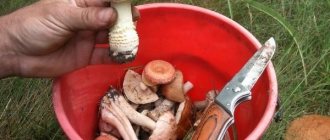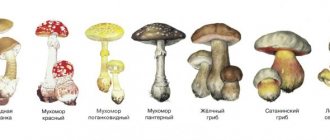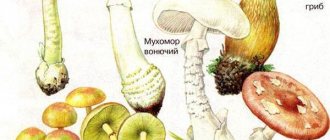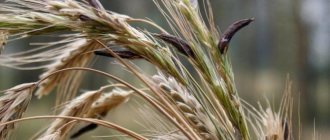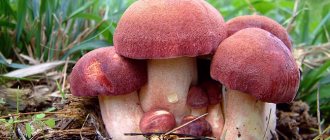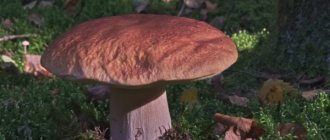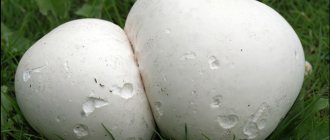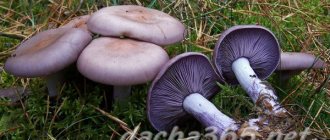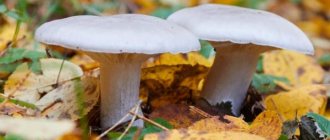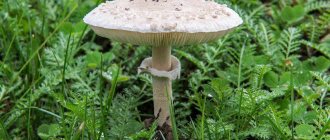Death cap (Amanita phalloides), the green variety of which is often called the green fly agaric, is the most dangerous poisonous mushroom in our forests. This mushroom of the Amanitaceae family, genus Amanita, has such a high concentration of phalloidin that all parts of it are deadly poisonous. Even a small piece of toadstool can lead to a tragic ending. When boiling, drying and other processing, the poison does not lose its strength.
Everyone knows what a pale grebe looks like. However, every year many people poisoned by this poisonous mushroom end up in hospitals in very serious condition. The fact is that the toadstool sometimes disguises itself as tasty edible mushrooms. For example, it is easy to confuse it with some champignons, russula, floats and rows. Those people who buy homemade, delicious-looking mushroom preparations also become victims.
Pallid grebe (photo from Wikipedia)
What does it look like
Toadstool is a cap-footed mushroom. The young plant looks like an egg, completely covered with a film. The hat has a convex shape with smooth, slightly curved edges. Size and color change as the plant grows. On average, the diameter of the cap of an adult mushroom is 6-10 cm, although in some specimens it can reach 15 cm. The top is flat and smooth, the inner side is equipped with a lamellar layer. The color can vary from olive or green in young plants to pale in adults.
The body of the mushroom is white with a fleshy structure. The leg is thin, cylindrical in shape with a thickened base, 1-1.5 cm in diameter and 8-16 cm long. The ring on the leg is white, flat. In an adult plant it disappears. The color of the leg is whitish or matches the color of the cap. At the base there is a wide cup-shaped volva 3-5 cm wide. Most often, it goes half into the ground. The spores are round and white.
You can see in detail what the pale grebe looks like in numerous photographs that are in encyclopedic and other publications on relevant topics.
What does a pale grebe look like?
Sulphur-yellow false honey fungus
Starting from June and until the end of November, until real frosts set in, honey fungus can be seen on rotten stumps and in forest windbreaks. Mushrooms grow from the wood in a whole bouquet, uniting in large flocks.
Distinctive features:
- the minimum cap diameter is 2 cm, the maximum is 7 cm;
- cap color - gradient from light yellow at the edges to brown-yellow in the middle;
- the leg is thin, can reach 10 cm in height;
- the flesh is light-colored and emits an unpleasant odor;
- The plates of honey fungus differ in color from the plates of edible honey mushrooms: they are greenish.
The first signs of sulfur-yellow honey fungus poisoning occur at least 60 minutes after eating.
Where does it grow
Amanita phalloides grows in deciduous and mixed forests of Eurasia, Asia and North America. Almost never found in coniferous forests. This is explained by the fact that the toadstool prefers fertile soils, and coniferous sandstones are not suitable for it. Most often, poisonous mushrooms can be found at the foot of oaks, hazels, beeches and birches.
They bear fruit regardless of whether they grow alone or in groups. Fruiting time is from August to November. This explains the fact that the mushroom is more common in August.
Where does it grow in Russia
The pale grebe in Russia grows in places with a temperate climate. Since it prefers fertile, moist soils, it can often be found not only in the forest or park, but also in garden plots.
Most often, the pale grebe is found in August.
Poisonous rower
The poisonous rower loves deciduous forests. But from time to time it is also found in coniferous plantings. You can see it for the first time only at the end of summer. She “lives” in the forest until the beginning of autumn. Favorite location: under the crown of an oak tree.
Distinctive features:
- the top has an off-white or ugly gray tint;
- the diameter of the cap can vary from a minimum of 4 cm to a maximum of 14 cm;
- with age, the bell-shaped apex becomes flat;
- in old mushrooms, the tips of the cap are curled inward;
- base diameter - 3 cm;
- smells like flour, but much more unpleasant than a product made from ground wheat;
- visually similar to the earthy-gray “sister”.
The first symptoms of poisoning by this very poisonous representative of eukaryotic organisms appear after a maximum of four hours.
Variability of the pale grebe
The inedible mushroom is characterized by changeability: as it grows, the color of the cap changes to a darker one, and the flesh develops an unpleasant odor. This feature makes it similar to other mushrooms, which can be called its counterparts.
Related species: stinking fly agaric or white toadstool, spring fly agaric, amanita bisporigera and amanita ocreata.
They all belong to the same fly agaric family, and each species has its own distinctive characteristics. Animals can eat them, but they are deadly to humans.
Yellow-skinned champignon
Yellow-skinned pechertsa is the second name of this popular poisonous resident of megacities. Most often, this representative of eukaryotic organisms dangerous to human health is found in city squares and parks. Especially after long summer rains.
Distinctive features:
- the cap of a young mushroom is dome-shaped;
- the cap of the “adult” mushroom straightens out, but does not become completely flat;
- the height of the “leg” can be from 10 cm to 15 cm;
- this eukaryotic element is colored white;
- the upper part of the leg is thinner, and the lower part is thicker;
- at the bottom of the eukaryotic organism there is a two-layer ring;
- If you try to cook such a forest “catch”, it begins to exude an unpleasant “pharmacy” aroma.
Eukaryotes belong to the poisonous family, but, as a rule, there is no fatal outcome after it enters the human body.
Use in folk medicine
The toadstool mushroom is used in alternative medicine. Homeopaths use it in minimal quantities as a remedy for poisoning with inedible types of mushrooms.
However, this technique raises many concerns, since non-compliance with the dosage can be fatal.
Use of toadstool in oncology
Poisonous mushroom against cancer
German scientists conducted experiments on laboratory animals. They were injected with a toxic substance - amanitin, extracted from a mushroom. It was discovered that the poison, once introduced into a cancer cell, inhibits its growth. As a result, the malignant neoplasm disappears.
Through numerous experiments, it was possible to develop a technique that made it possible to treat cancerous tumors without causing additional harm to health. The poison not only destroyed cancer cells, but also prevented the development of metastases. To treat some types of cancer, just a few injections were enough. Despite the experience gained, doctors have not yet used this technique to treat people.
How to distinguish from edible mushrooms
In nature, there are many mushrooms that look like deadly ones. They can be found not only among poisonous, but also among useful specimens. All lovers of quiet hunting should know how to distinguish toadstools from edible mushrooms. Inexperienced mushroom pickers may confuse them and mistake them for edible species. Most often they can be confused with champignons, honey mushrooms, green or greenish russula, greenfinches or floats. To prevent this from happening, every mushroom picker, before going into the forest, should study the pale toadstool, a description of which is in many relevant publications.
Greenfinch mushroom
Greenfinch
The external structure of the greenfinch resembles a deadly mushroom. A distinctive feature is the color of the stem and cap. The edible mushroom has a pleasant lemon green color. In addition, its cap is straight with smooth edges, and not curved like a toadstool. The surface is smooth, the structure is dense and fleshy. In young specimens the cap is slightly convex, in mature specimens it is raised upward. The greenfinch has a short, strong leg, without a characteristic “skirt,” covered with small brown scales.
The greenfinch grows in the sandy soil of a coniferous forest. Toadstools are rarely found in such places. This circumstance can be considered the main difference between the two types of mushrooms.
Honey mushrooms
Toadstools are often mistaken for edible honey mushrooms. The mushrooms look similar. The legs of honey mushrooms have a small “skirt”. The color of the cap is pale sandy-brown. The main distinguishing feature of a useful specimen is the presence of scales on the cap, as well as the cream color of the plates and a pleasant smell.
False honey mushrooms, which belong to the inedible class, are rarely confused with toadstool. This variety does not have a ring on the stem, and the cap is bright brown.
What does champignon look like?
Champignon
Experienced mushroom pickers can easily distinguish an edible champignon from a poisonous mushroom, despite the external similarity of the legs.
Attention should be paid to the plates located under the cap. In champignon they are pink or brown, while in toadstool they are white.
The poisonous toadstool is more like a false champignon. Its leg is yellowish in color. And if you break the cap, yellow spots will appear along the edges of the break.
Green and greenish russula
The color and shape of the russula cap resembles a toadstool. Therefore, you cannot be guided by this sign when picking mushrooms. The main difference is the leg. In russula it is straight. There is no ring, volva or tuberous thickening on it. In addition, the edible specimen has a pleasant smell, unlike an adult poisonous mushroom, which smells unpleasant.
Float gray
Float
This edible mushroom is unattractive in appearance and looks like a toadstool. This feature often misleads even experienced mushroom pickers. The main difference can be considered the presence of a thin leg without a characteristic ring and a dirty gray cap with rough edges. When damaged, the color of the pulp does not change. In addition, the float is smaller in size. Lives in mixed or deciduous forests.
White or spring fly agaric
The unpleasant-smelling white fly agaric, called the spring fly agaric in a number of sources, is a regular in forest areas. It can be found in forests from June to September.
Distinctive features:
- the cap is painted white;
- the average diameter of the apex is 8 cm;
- In some fly agarics of this variety, the edge of the cap is indented in places;
- the maximum length of the leg is 12 cm;
- the leg inside is empty;
- over the entire area it is covered with scales, visually reminiscent of rags;
- the leg ends in a characteristic ring of relatively large diameter compared to itself.
The white fly agaric is visually similar to an edible mushroom called white float. However, the latter lacks a ring, which is a characteristic feature of a deadly poisonous representative of eukaryotic organisms.
How to get rid of toadstool in the garden?
If a toadstool appears in a garden, vegetable garden or other place on a personal plot, you need to remove it as quickly as possible in order to free the cultivated plants from the unwanted neighborhood. The toadstool must be uprooted and destroyed.
If a group of poisonous mushrooms is found, they should be pulled out. Then, to get rid of the mycelium, lift the top layer of soil and, if possible, remove the mushroom threads. If this is problematic, then leave the layer of earth raised for several days. The sun's rays will completely destroy the remnants of the fungal root system. Then dig up the place where they grew. If there are too many of them, then you will have to fight them with the help of special garden chemicals.
Pale toadstool needs to be uprooted
To prevent the future appearance of green fly agaric in the garden plot, you should clear the area of rotten and rotten wood. It is necessary to periodically remove weeds and tall grass from the area to avoid the appearance of dark, damp areas that poisonous mushrooms love. In those places where toadstool was once found, you need to periodically loosen the soil.
Recipe for pickled cap
This method is considered one of the fastest and easiest. The collected caps, or chickens, as they are also called, must be processed immediately, otherwise they will spoil. If this is not possible, you need to at least peel them and boil them in salt water. In this form they can be stored for up to 5 days in a cold place.
- Pour water, vinegar into an enamel pan, add salt and sugar. Boil.
- Place the prepared caps and bay leaves into the pan. Cook for ¼ hour over low heat, periodically collecting foam. If you don't collect it, the marinade will be cloudy.
- Add acid and turn off the stove. Wait until the chickens cool down a little.
- Place the mushrooms in sterilized jars and pour in the marinade.
Roll up and store in a cool place.
Symptoms and signs of poisoning
The danger of toadstool poisoning lies in the fact that the first symptoms of poisoning do not appear immediately, but after several hours. Evidence that there are toxic substances in the body will be the appearance of acute pain in the stomach and intestines, vomiting, diarrhea, and severe thirst. Diarrhea and vomiting will be so severe and frequent that even medications will not help stop them. Feces with diarrhea will be watery and yellow-green in color.
First symptoms of poisoning
The effect of poison on the human body
The effect of a poisonous mushroom on the human body can be divided into several stages.
- Latent or incubation period. Lasts 1-2 days after poisoning with toadstools. No signs of intoxication are observed during this period, however, toxic substances have already penetrated into the blood and begun their destructive effect.
- The first symptoms of intoxication. The fact that the body is poisoned is indicated by the appearance of acute pain, vomiting and diarrhea. The occurrence of unpleasant symptoms occurs against the background of inflammation of the intestinal and stomach mucous membranes caused by the penetration of toxins. During this period, a person suffers from severe dehydration, which provokes a drop in blood pressure. Severe weakness, dizziness, and convulsions occur. The person may lose consciousness. A similar picture is observed within 2 days.
- A period of imaginary calm. For some time, all symptoms of intoxication may disappear. The duration of this period is no more than 12 hours. The patient may have a false sense of quick recovery. But at this time, the poison that has entered the body continues its destructive effect, and if its dose was too large, sudden death may occur.
- Damage to internal organs. Toxins have a destructive effect on the liver, which can cause severe pain in the right hypochondrium. Symptoms resemble the development of renal failure. At this stage, the patient may develop yellowness of the skin, mucous membranes of the eyes and mouth.
Eating 1/3 of a mushroom cap poses a mortal danger to humans. When such an amount of poison enters the body, heart failure develops, the kidneys and liver are deeply affected, and death occurs as a result. Death can occur within 6-7 days, but if the victim does not receive the necessary assistance, he may die within the first day after poisoning.
Timely treatment allows you to get rid of signs of intoxication without a trace. Internal organs are restored after removing toxins.
First aid for poisoning
In case of poisoning, the victim must be provided with assistance as quickly as possible. His life depends on it. When the first symptoms of poisoning appear, you must quickly rinse your stomach. The patient should be asked to drink at least 1 liter of clean water and induce vomiting by pressing with the fingers on the root of the tongue. The procedure is repeated at least 5-6 times. In addition, the patient can be offered to take sorbents that will accelerate the removal of harmful substances from the body. In this situation, those that need to be diluted with water before use are more suitable.
Qualified assistance for poisoning with toadstool
However, if several hours have passed since the moment of poisoning, then the poison has entered the blood. Simple gastric lavage in this situation will not be enough. It is necessary to call a medical team or take the victim to the hospital in another way to provide more qualified assistance in case of poisoning.
In a medical facility, gastric lavage will be performed using a tube, which is much more effective than a home procedure. Sorbents and laxatives will be prescribed. To restore a weakened body, the doctor will prescribe vitamin complexes, including vitamin C, as well as drugs that restore the microflora of the intestines and stomach.
Interesting Facts
- The spores of the Pale Toadstool are elliptical in shape and smooth to the touch.
- Claudius, the Roman emperor, was poisoned with toadstool. His wife added mushroom to lunch. After the death of Claudius, Nero took his throne.
- Toadstool spores usually infect nearby growing mushrooms and they become inedible.
- One of the Popes, Clement VII, died as a result of poisoning with toadstool.
- Even 40 g of this mushroom is deadly. No treatment can destroy the poison.
- About 50% of poisonings of species from the kingdom of mushrooms are due to poisoning by fly agaric mushrooms.
- Recently, scientists noticed that in California, Toadstool formed mycorrhiza with hemlock, and in Iran, this fungus cooperated with hazelnuts. In Algeria, the mushroom formed an alliance with eucalyptus.
- The Pallid Grebe usually grows in clumps and is found from mid-summer to September.
- Many animals eat this mushroom because their gastrointestinal tract can neutralize all dangerous substances.
